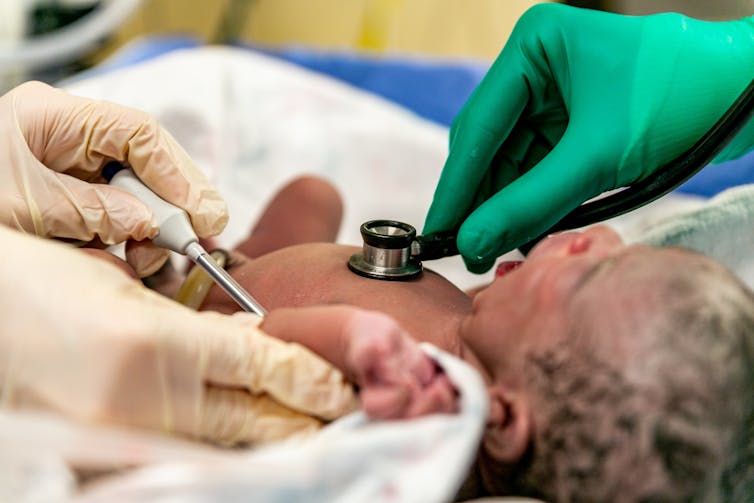Most women who give birth in Australia are monitored with CTG. But it might not be the best approach
- Written by Kirsten Small, Obstetrician and researcher, Griffith University
Pregnant women rightly expect that when they’re in labour, medical staff will observe them and their baby closely, and can deal with any potential problems quickly.
The majority of women who give birth in Australia are monitored with a cardiotocograph (CTG monitoring). But this isn’t the only way.
Research shows women want to be included in making decisions about how to monitor the baby, but often are not.
In this article, we set out some of the pros and cons for each option, to help women take an active role in deciding what’s best for them and their baby.
What is foetal monitoring?
Foetal monitoring during labour focuses on detecting particular changes in the baby’s heart rate, so doctors and midwives can respond if a problem is found.
This could be as simple as asking the woman to change position, or in other circumstances, medical staff might recommend a caesarean section. The goal is to prevent the baby dying, or suffering brain damage as a result of low oxygen levels during labour.
The first method of foetal monitoring is intermittent auscultation. The midwife or doctor will typically listen to the baby’s heart rate for one minute every 15-30 minutes, including during contractions, using a device called a foetal doppler. Foetal dopplers use ultrasound to detect the baby’s heartbeat.
The second approach is CTG monitoring. CTG records the baby’s heart rate and the strength of the woman’s contractions, usually by placing two recording discs on the woman’s abdomen, which are held in place with straps. The information is then plotted on a graph, helping the midwife or doctor understand how the baby responds during the pressure of a contraction.
Read more: Tokophobia is an extreme fear of childbirth. Here's how to recognise and treat it
So, what’s the difference?
CTG monitoring is the most common approach to foetal monitoring in Australia and other high-income countries, and is usually used continuously throughout labour.
Some women find the straps used to keep the monitoring devices in place uncomfortable. Depending on the specific equipment, women may need to remain lying on a bed, and therefore find their movements are restricted.
Some, but not all CTG monitors can be used in the shower or a birthing pool. So women being monitored with CTG may not be able to access these options, which bring comfort to some women during labour.
Conversely, intermittent auscultation leaves the woman free to move in between episodes of monitoring, when she is not attached to the equipment.
 Women want to be involved in making decisions about their labour.
Shutterstock
Women want to be involved in making decisions about their labour.
Shutterstock
While intermittent monitoring may be preferable from the perspective of the woman’s comfort, let’s look at how the two approaches compare on three important outcomes for mother and baby.
Women at low risk
Women who don’t have any risk factors that may increase the likelihood of complications for their baby are considered low risk.
A Cochrane review comparing intermittent auscultation with CTG monitoring showed no significant difference in the rare event of babies dying during labour or soon after among low-risk women (seven deaths per 10,000 births).
Cerebral palsy is a type of permanent brain injury that may sometimes occur due to low oxygen levels during labour. No research has looked at how the foetal monitoring approach used affects the rate of babies born with cerebral palsy in low-risk women.
Caesarean section was twice as common in women monitored by CTG compared with intermittent auscultation. We don’t know why, although it might have something to do with the fact women monitored with CTG often report not being able to move freely during labour.
Given caesarean section is associated with a higher rate of complications for the mother such as heavy bleeding or infection, and increased rates of miscarriage and stillbirth in subsequent pregnancies, intermittent auscultation is the safer monitoring option for low-risk women.
Read more: Why labour is such a pain – and how to reduce it
Women at higher risk
Some factors (for example, having a baby that’s smaller than expected, giving birth prematurely, or having diabetes) are associated with a greater chance of poor outcomes for the baby. Women with risk factors such as these are considered high risk.
We recently reviewed the evidence comparing the use of intermittent auscultation and CTG monitoring for high-risk women. CTG was again no better than intermittent auscultation in preventing babies dying during labour or soon after (16 deaths per 10,000 births).
However, cerebral palsy rates were almost three times higher with CTG monitoring over intermittent auscultation (going from 769 to 1,951 babies per 10,000 births). We don’t know why this is.
 Foetal monitoring during labour looks for changes in the baby’s heart rate.
Solen Feyissa/Unsplash
Foetal monitoring during labour looks for changes in the baby’s heart rate.
Solen Feyissa/Unsplash
Once again, the caesarean section rate almost doubled with CTG monitoring.
Poor outcomes such as cerebral palsy and perinatal death occur more often in high-risk women, but remain relatively uncommon. Research shows the use of CTG rather than intermittent auscultation doesn’t reduce the likelihood of these outcomes, but does increase the risk to women by making it more likely they will give birth by caesarean section.
Making a decision
Intermittent auscultation is generally the recommended monitoring technique when there are no risk factors. But all major international foetal monitoring guidelines advise CTG monitoring should be used for women considered to be at high risk, despite the evidence.
As a consequence, clinicians don’t always explain foetal monitoring choices to women with risk factors in a way that helps them make up their own mind about how they want their baby to be monitored during labour.
Notably, much of the research we have on this topic is now dated, and not necessarily of optimal quality. It’s important that recommendations in professional guidelines align with research evidence and support midwives and doctors to help women make personalised and informed decisions about their own care.
If you’re expecting a baby, talk to your midwife who will be able to discuss the advantages and disadvantages of each foetal monitoring option with you in light of your personal situation.
Read more: Having a scan? Here’s how the different types work and what they can find
Authors: Kirsten Small, Obstetrician and researcher, Griffith University





